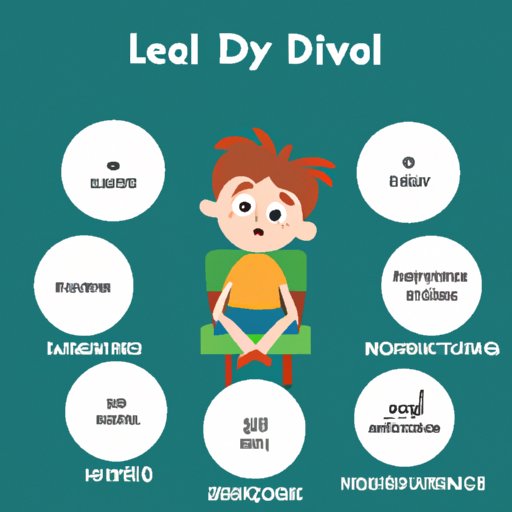
Introduction
Nonverbal Learning Disorder (NVLD) is a complex and often misunderstood learning disability. It affects various aspects of an individual’s life, from social interactions to academic success. The purpose of this article is to help readers understand what NVLD is and how it impacts those living with it. This article is written for parents, educators, and individuals looking to learn more about NVLD.
Understanding Nonverbal Learning Disorder: Symptoms, Diagnosis, and Treatment
Nonverbal Learning Disorder is a learning disability that impacts visual-spatial, motor, and social skills. Individuals with NVLD may have difficulty understanding nonverbal cues, such as body language and facial expressions. They may also struggle with coordination, organization, and abstract thinking.
Common symptoms of NVLD include:
- Difficulty reading maps or understanding spatial relationships
- Poor handwriting and coordination
- Trouble with math concepts or problem-solving tasks
- Misinterpreting social cues or facial expressions
- Literal interpretation of language and difficulty with abstract concepts
Diagnosing NVLD involves a comprehensive evaluation of an individual’s cognitive, academic, social, and emotional functioning. This evaluation may include psychological and educational testing, interviews with parents and teachers, and observation of the individual’s behavior.
Treatment options for NVLD include cognitive-behavioral therapy, social skills training, and occupational therapy. Additionally, accommodations may be made in educational and occupational settings to help individuals with NVLD succeed.
Breaking Down Nonverbal Learning Disorder: How It Affects Learning and Development
NVLD can have a significant impact on learning and development. Children and adolescents with NVLD may struggle academically, particularly in math and reading comprehension. They may also have difficulty with fine motor tasks, such as handwriting or using scissors.
Furthermore, NVLD can impact overall development, including social skills, emotional regulation, and self-esteem. Children with NVLD may struggle to make friends or understand social norms and expectations. They may also experience anxiety or depression due to the challenges of living with NVLD.
The Invisible Disability: Living with Nonverbal Learning Disorder
Living with NVLD can be challenging, and many individuals with this learning disability face invisible obstacles every day. For instance, they may have difficulty with nonverbal cues and may struggle to understand jokes, sarcasm, or implied meanings. They may also experience difficulties with coordination or organization, which can make everyday tasks more time-consuming and frustrating.
Unfortunately, NVLD is often overlooked or misunderstood because it is not well-known, despite impacting up to 3% of the population. Many individuals with NVLD may go undiagnosed until later in life, leading to missed opportunities for intervention and support.
Challenges and Triumphs: Stories of those with Nonverbal Learning Disorder
Despite the many challenges that come with NVLD, individuals with this learning disability can and do succeed. Here are several personal stories that highlight the challenges and triumphs experienced by people living with NVLD:
“I have always had difficulty with directions and understanding spatial relationships. When I was younger, this made it difficult to play games that required navigation skills. As I got older, I decided to pursue my passion for music. While playing instruments did not come easy, I learned that with extra time and effort, I could become an accomplished musician.”
“I struggled in school because I could not read social cues. I felt like an outsider and had trouble making friends. Eventually, I discovered a love for creative writing and found solace in expressing myself through words. Writing became an outlet, and through it, I was able to connect with others in a new way.”
“One of my biggest challenges was organizing my thoughts and staying focused. This made it difficult to complete tasks, whether it was schoolwork or everyday chores. However, I found that making to-do lists and breaking tasks into smaller, manageable steps helped me stay on track. This enabled me to accomplish goals and feel a sense of pride in my achievements.”
Nonverbal Learning Disorder in Children and Adolescents: Strategies for Academic Success
Children and adolescents with NVLD may struggle academically, but there are strategies that can help them succeed:
- Provide visual aids or graphic organizers to help with information processing
- Break down tasks or assignments into smaller parts
- Use repetition and hands-on activities to reinforce learning
- Teach social skills explicitly, such as how to read body language or engage in small talk
- Provide a positive learning environment that emphasizes effort over results
What Parents and Educators Should Know About Nonverbal Learning Disorder
Parents and educators play a crucial role in identifying and supporting children with NVLD. Here are several points that parents and educators should keep in mind:
- Watch for signs of NVLD, such as difficulty with social skills, coordination, or abstract thinking
- Encourage open communication with children about their struggles and strengths
- Explore potential accommodations in educational and occupational settings
- Provide positive reinforcement and praise for effort and progress
- Foster a supportive and inclusive environment that celebrates diversity
My Journey with Nonverbal Learning Disorder: One Person’s Experience
Living with NVLD can be challenging, but it is possible to overcome obstacles and find success. Here is one person’s journey with NVLD:
“Growing up, I struggled with social skills and organization. I felt like I was on the outside looking in, and it was difficult to connect with others. However, I discovered my passion for photography, and through my lens, I was able to see the world in a new way. Photography became my voice, and it gave me a sense of purpose and belonging.”
Conclusion
Nonverbal Learning Disorder is a complex learning disability that impacts visual-spatial, motor, and social skills. Understanding the symptoms, diagnosis, and treatment options for NVLD is crucial for individuals, parents, and educators. With the right support and accommodations, individuals with NVLD can overcome challenges and find success in academics, social interactions, and daily life. If you or someone you know may be living with NVLD, seek out resources, such as educational and behavioral specialists, to better support you or your loved one.




